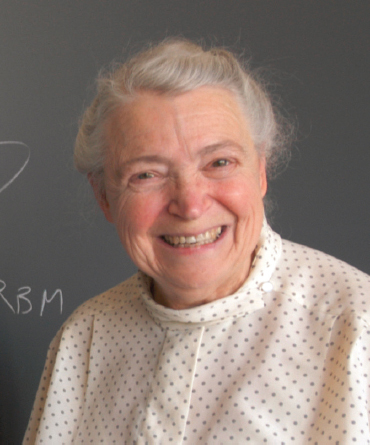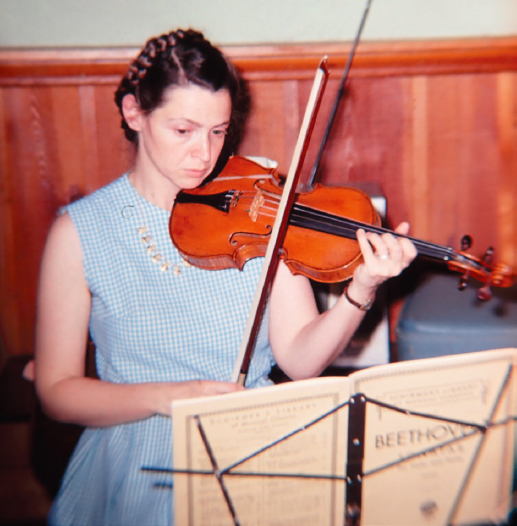

MILDRED S. DRESSELHAUS
1930–2017
Elected in 1974
“Contributions to the experimental studies of metals and semimetals, and to education.”
BY JING KONG AND TOMÁS PALACIOS SUBMITTED BY THE NAE HOME SECRETARY
MILDRED SPIEWAK DRESSELHAUS, a pioneer and one of the most influential leaders in the field of nanoscience and technology, died February 20, 2017, at the age of 86.
Millie was born November 11, 1930, in Brooklyn, New York, to Ethel (née Teichtheil) and Meyer Spiewak, two Polish Jewish immigrants. Her youth was marked by very limited financial resources, requiring her and her older brother Irving to start working at a young age to help support the family. One of her early jobs was tutoring a special education child, and the experience was key to Millie’s discovery of her passion for working with students and helping them understand complex concepts. And because she knew the sufferings of the poor and disadvantaged, she sought throughout her life to help as many as she could through her work.
Millie was also an exceptional violin player; her love of music and the violin lasted throughout her life—she played her violin almost every day. As a young girl she received a scholarship to a music school, where she befriended children whose academic school environments far exceeded the educational opportunities at her neighborhood school. The divide (and her brother’s encouragement) motivated her, at age 13, to apply for a spot at the competitive Hunter College High School for Girls.
Millie’s brilliant mind was vividly captured early on by a ditty in the Hunter High School yearbook: “Mildred Spiewak: Any equation she can solve, every problem she can resolve. Mildred equals brains plus fun. In math and science she’s second to none.”
She went on to receive her AB in liberal arts from Hunter College of the City University of New York (1951), where she took a class with Rosalyn Yalow, the future Nobel Prize winner, who became a lifelong mentor and encouraged her to become a physicist. With a Fulbright Fellowship, she then studied for a year at the University of Cambridge (Newnham College). She returned stateside and in 1953 earned her MA in physics from Radcliffe College at Harvard University. Five years later she got her PhD, also in physics, from the University of Chicago on the microwave properties of a superconductor in a magnetic field. She met Enrico Fermi, who had a great influence on her although unfortunately he passed away in 1954. Millie always remembered the early morning walks with Fermi on their way to the university.
While in Chicago she met her husband Gene Dresselhaus, a theoretical physicist well known for his work on spin-orbit interaction effects in solids. In 1960 they both became staff members at MIT Lincoln Laboratory.
In 1967 Millie was appointed the Abby Rockefeller Mauze Visiting Professor in the Department of Electrical Engineering at the Massachusetts Institute of Technology. The next year she became a tenured faculty member in the department and in 1983 a joint professor in physics. In 1985 she was the first woman appointed Institute Professor, MIT’s highest honor for distinguished accomplishments in scholarship, education, service, and leadership. Throughout her 50 years at MIT, she was a remarkable inspiration and influence on campus.
In terms of her technical accomplishments, Millie was one of the pioneers and most prominent experts in the study of carbon science. From 1975 to 1990, she published extensive work on graphite intercalation compounds, which became highly influential in graphite research. Overall she authored or coauthored nine books and some 1700 papers during her career.
Her insights about the link between zero dimensional fullerenes and macroscopic carbon fibers spurred the first observation of carbon nanotubes in 1991 and their study for years to follow. Her theoretical work demonstrated that the semiconducting or metallic behavior of a single-walled nanotube (SWNT) is determined by its geometric structure. This theoretical prediction came before SWNTs could be synthesized and greatly stimulated and inspired the experimental work in carbon nanotube research. These experimental efforts quickly broadened to cover synthesis, characterization, separation, and their use for fundamental physics studies and transistor applications.
In 1998 Millie accelerated carbon nanotube research again with her discovery of individul SWNT Raman spectroscopy. This technique revolutionized understanding of how individual molecules can be probed macroscopically and enabled breakthroughs in fields as diverse as catalyst research, DNA hybridization, and single molecule sensors. Her findings paved the way for others’ work that was recognized by at least two Nobel Prizes—for fullerenes in 1996 and graphene in 2010—and earned her the nickname “the Queen of Carbon Science.”
Millie’s great scientific contributions were not limited to carbon. In 2012 she received the prestigious Kavli Prize in Nanoscience (the first solo recipient) for “her pioneering contributions to the study of phonons, electron-phonon interactions, and thermal transport in nanostructures.”
Her contributions to the use of nanostructures in thermoelectrics have defined the modern directions of this field. The dimensionless thermoelectric figure of merit (ZT) in the best thermoelectric materials had remained near 1 for over 50 years. In 1993 she proposed that it might be possible to increase the ZT of certain materials by preparing them in quantum-well superlattice structures or in one-dimensional form, such as in nanowires. Her seminal papers on this topic, cited more than 4000 times, enabled experimental breakthroughs in the ZT value of nanostructured thermoelectrics. In many ways Millie’s research helped usher in the age of nanotechnology.
Throughout, Millie was a prominent advocate for women pursuing careers in science and engineering. In 1971 she and a colleague began the Women’s Forum at MIT, a seminar series exploring the roles of women in science and engineering. And in 1973 she received a Carnegie Foundation grant supporting her efforts to encourage women to enter traditionally male-dominated fields like physics and engineering.
For a number of years she also led an MIT seminar in engineering for first-year undergraduate students; originally designed to build the confidence of female students, it drew a large audience of both men and women. In all her travels around the world to give speeches and seminars at labs and universities, she always made an effort to meet female students and encourage them toward their careers. She was a much-loved mentor and an inspiring role model worldwide.
Equally remarkable was Millie’s service to the scientific community, at MIT, nationally, and globally. As associate department head of the MIT Department of Electrical Engineering (1972–74) she was instrumental in starting the computer science part of the department. As head of the MIT Center for Materials Science and Engineering (1977–83) she helped multiple junior faculty members.
At the national level, she was appointed director of the Office of Science at the US Department of Energy (2000–08), and cochaired a highly influential 2003 DOE study, Basic Research Needs for the Hydrogen Economy. In addition, she was active in the professional societies; she chaired the governing board of the American Institute of Physics and served as president of the American Physical Society and the American Association for the Advancement of Science.
She also served on countless advisory boards and committees and was exceptionally active in the work of the National Academies. In addition to her service over decades (1984–2014) on numerous internal NAE and NAS committees (e.g., on membership, nominations) as well as the Academies’ Governing Board and both the NAE and NAS councils, she was appointed to the committees on an Assessment of and Outlook for Condensed-Matter and Materials Physics (cochair;
2006–07); Global Dialogues on Emerging Science and Technology (2004–06); Facilitating Interdisciplinary Research (2003–04); Human Rights (1997–2000); Capitalizing on US Leadership in Fields of Science (1996–99); and Women in Science, Engineering, and Medicine (chair; 1990–93), among others.
Her many civic, social, and scientific contributions were recognized with numerous awards and honors. Among them were the Presidential Medal of Freedom (2014), the highest honor bestowed by the US government on American civilians; the National Medal of Science (1990), given to the nation’s top scientists; the IEEE Medal of Honor (2015)—for which she was the first female recipient—for “leadership and contributions across many fields of science and engineering”; the Enrico Fermi Award (2012) from the US Department of Energy for her “leadership in condensed matter physics, in energy and science policy, in service to the scientific community, and in mentoring women in the sciences”; and the Vannevar Bush Award (2009). She was elected to the National Academy of Engineering (1974) and National Academy of Sciences (1985) and inducted to the National Inventors Hall of Fame (2014). In addition, she was awarded nearly 30 honorary doctorates from institutions worldwide.
When asked why she spent so much time on civic and social efforts for science, Millie cited the time she played violin for Eleanor Roosevelt as a child in her after-school music class. The first lady was a true inspiration for young Millie and ignited in her a deep call to service. Millie said she owed her country, and potential great women everywhere, a debt of gratitude, because they helped form her into the woman she became.
Millie was a beloved giant who left a tremendous legacy. Her eminent contributions and persistent endeavors to the benefit of the scientific community, her deep care for her students and colleagues, and her dedicated service to her country and beyond will leave an enduring impact on generations to come. She is greatly missed.
Millie was survived by her husband, Gene (he died September 29, 2021); their children Marianne (Geoffrey), Carl, Paul (Maria), and Eliot (Françoise); and five grandchildren.






